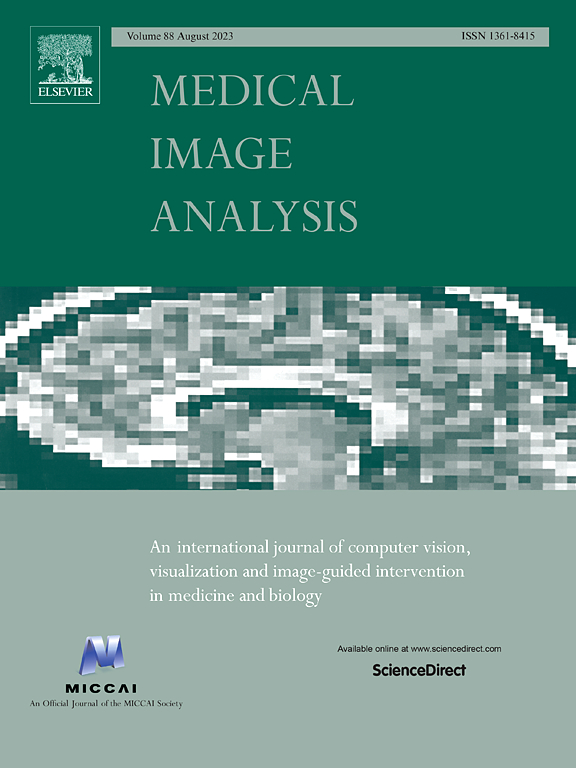IF 10.7
1区 医学
Q1 COMPUTER SCIENCE, ARTIFICIAL INTELLIGENCE
引用次数: 0
摘要
心脏数字双胞胎(CDTs)为推断与心脏机制相关的多尺度属性提供了个性化的样本内心脏表征。创建 CDTs 需要躯干上电极位置的精确信息,特别是用于个性化心电图(ECG)校准。然而,目前的研究通常依赖于额外的躯干成像采集和手动/半自动的心电图电极定位方法。在本研究中,我们提出了一种新颖高效的拓扑信息模型,可从二维临床标准心脏磁共振成像中全自动提取个性化心电图标准电极位置。具体来说,我们从心脏核磁共振图像中获取稀疏的躯干轮廓,然后根据轮廓定位 12 导联心电图的标准电极。心脏核磁共振成像的目标是心脏而不是躯干,这导致成像中的躯干几何形状不完整。为了解决拓扑结构缺失的问题,我们将电极作为关键点的一个子集,这样就可以明确地与三维躯干拓扑结构对齐。实验结果表明,所提出的模型在准确性(欧氏距离:1.24±0.293 厘米对 1.48±0.362 厘米)和效率(2 秒对 30-35 分钟)方面都优于耗时的传统基于模型投影的方法。我们还进一步证明了使用检测到的电极进行内模拟心电图的有效性,凸显了它们在创建准确、高效的 CDT 模型方面的潜力。代码见 https://github.com/lileitech/12lead_ECG_electrode_localizer。本文章由计算机程序翻译,如有差异,请以英文原文为准。
Personalized topology-informed localization of standard 12-lead ECG electrode placement from incomplete cardiac MRIs for efficient cardiac digital twins
Cardiac digital twins (CDTs) offer personalized in-silico cardiac representations for the inference of multi-scale properties tied to cardiac mechanisms. The creation of CDTs requires precise information about the electrode position on the torso, especially for the personalized electrocardiogram (ECG) calibration. However, current studies commonly rely on additional acquisition of torso imaging and manual/semi-automatic methods for ECG electrode localization. In this study, we propose a novel and efficient topology-informed model to fully automatically extract personalized ECG standard electrode locations from 2D clinically standard cardiac MRIs. Specifically, we obtain the sparse torso contours from the cardiac MRIs and then localize the standard electrodes of 12-lead ECG from the contours. Cardiac MRIs aim at imaging of the heart instead of the torso, leading to incomplete torso geometry within the imaging. To tackle the missing topology, we incorporate the electrodes as a subset of the keypoints, which can be explicitly aligned with the 3D torso topology. The experimental results demonstrate that the proposed model outperforms the time-consuming conventional model projection-based method in terms of accuracy (Euclidean distance: cm vs. cm) and efficiency (2 s vs. 30-35 min). We further demonstrate the effectiveness of using the detected electrodes for in-silico ECG simulation, highlighting their potential for creating accurate and efficient CDT models. The code is available at https://github.com/lileitech/12lead_ECG_electrode_localizer.
求助全文
通过发布文献求助,成功后即可免费获取论文全文。
去求助
来源期刊

Medical image analysis
工程技术-工程:生物医学
CiteScore
22.10
自引率
6.40%
发文量
309
审稿时长
6.6 months
期刊介绍:
Medical Image Analysis serves as a platform for sharing new research findings in the realm of medical and biological image analysis, with a focus on applications of computer vision, virtual reality, and robotics to biomedical imaging challenges. The journal prioritizes the publication of high-quality, original papers contributing to the fundamental science of processing, analyzing, and utilizing medical and biological images. It welcomes approaches utilizing biomedical image datasets across all spatial scales, from molecular/cellular imaging to tissue/organ imaging.
 求助内容:
求助内容: 应助结果提醒方式:
应助结果提醒方式:


